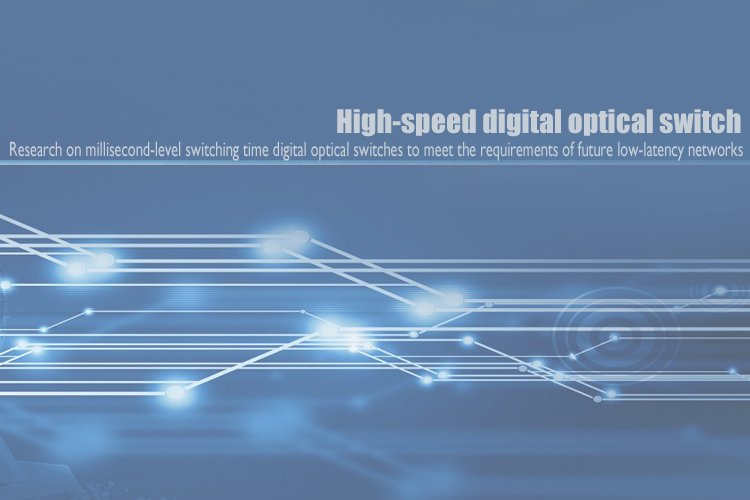High-Speed Digital Optical Switches:
Pioneering Millisecond-Level Switching for Future Low-Latency Networks
Introduction
The digital world is evolving at an unprecedented pace, and the demand for faster, more efficient data transmission is growing exponentially. At the heart of this digital revolution are high-speed digital optical switches, the unsung heroes of our interconnected world. These devices, capable of millisecond-level switching times, are set to redefine the landscape of future low-latency networks.
 The Evolution of Digital Optical Switches
The Evolution of Digital Optical Switches
Digital optical switches have come a long way since their inception. Early models were plagued by slow switching times and high latency, making them unsuitable for high-speed data transmission. However, recent advancements in technology have led to the development of high-speed digital optical switches capable of millisecond-level switching times. These switches are not only faster but also more efficient, making them ideal for future low-latency networks.
The Mechanics of High-Speed Digital Optical Switches
High-speed digital optical switches operate by directing light signals through different paths within an optical fiber network. The switch can change the path of the light signal in milliseconds, allowing for rapid data transmission. This speed is achieved through the use of advanced materials and innovative design techniques, which minimize the time it takes for the switch to respond to changes in the light signal.
The Role of High-Speed Digital Optical Switches in Low-Latency Networks
Low-latency networks are essential for a range of applications, from high-frequency trading to online gaming. High-speed digital optical switches play a crucial role in these networks by ensuring that data is transmitted quickly and efficiently. By reducing the time it takes for data to travel from one point to another, these switches can significantly improve the performance of low-latency networks.
The Future of High-Speed Digital Optical Switches
The future of high-speed digital optical switches is bright. As the demand for faster data transmission continues to grow, these switches are set to become an integral part of our digital infrastructure. With ongoing research and development, we can expect to see even faster switching times and lower latency in the future.
Conclusion
High-speed digital optical switches are at the forefront of the digital revolution. With their ability to deliver millisecond-level switching times, these devices are set to transform the future of low-latency networks. As we continue to push the boundaries of what is possible, high-speed digital optical switches will undoubtedly play a crucial role in shaping our digital future.
FAQs
Q1. What are high-speed digital optical switches?
High-speed digital optical switches are devices that direct light signals through different paths within an optical fiber network. They are capable of changing the path of the light signal in milliseconds, allowing for rapid data transmission.
Q2. How do high-speed digital optical switches work?
These switches operate by using advanced materials and innovative design techniques to minimize the time it takes for the switch to respond to changes in the light signal. This allows them to achieve millisecond-level switching times.
Q3. Why are high-speed digital optical switches important for low-latency networks?
High-speed digital optical switches are crucial for low-latency networks because they ensure that data is transmitted quickly and efficiently. By reducing the time it takes for data to travel from one point to another, these switches can significantly improve the performance of low-latency networks.
Q4. What applications can benefit from high-speed digital optical switches?
Applications that require rapid data transmission, such as high-frequency trading and online gaming, can greatly benefit from high-speed digital optical switches. These switches can also be beneficial for cloud computing and data center networks.
Q5. What is the future of high-speed digital optical switches?
The future of high-speed digital optical switches is promising. As the demand for faster data transmission continues to grow, these switches are set to become an integral part of our digital infrastructure. Ongoing research and development are expected to lead to even faster switching times and lower latency.
Keywords: High-Speed Digital Optical Switches, Millisecond-Level Switching, Low-Latency Networks, Data Transmission, Future of Digital Infrastructure.

 The Future of Fiber Optic Communication Network Architecture: Evolution and the Role of SDON Technology
The Future of Fiber Optic Communication Network Architecture: Evolution and the Role of SDON Technology
 What opportunities and challenges does free-space optical communication technology face?
What opportunities and challenges does free-space optical communication technology face?
 Opelink MPO Products for High-Speed Data Center Applications
Opelink MPO Products for High-Speed Data Center Applications
 CWDM vs. DWDM: Which Optical Transmission Technology Should You Choose?
CWDM vs. DWDM: Which Optical Transmission Technology Should You Choose?